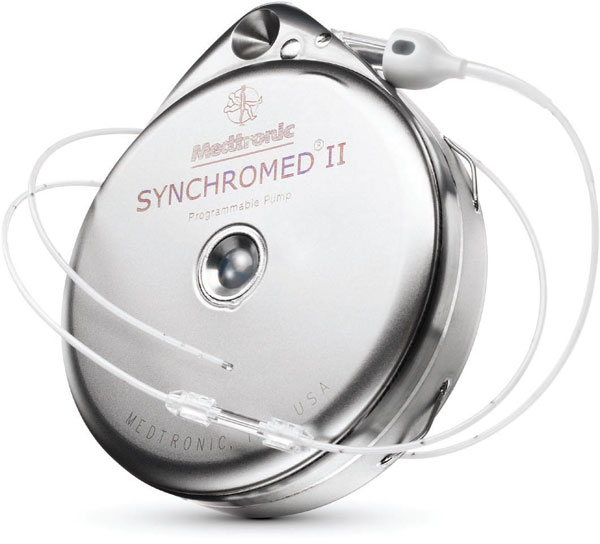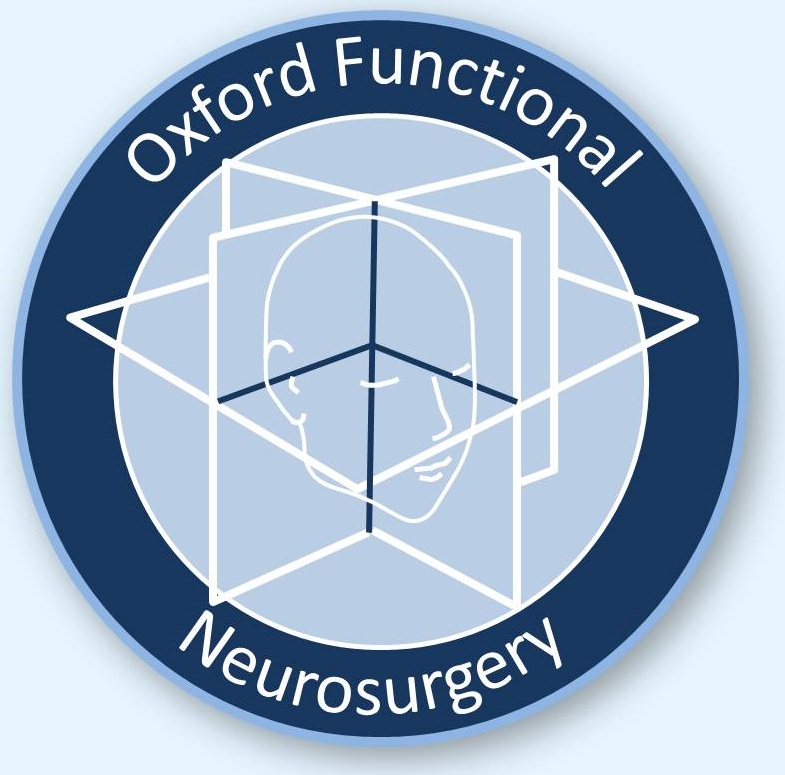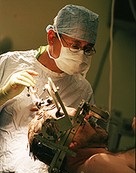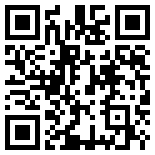Intrathecal drug delivery
Intrathecal Drug Delivery (ITDD) systems are used for the treatment of spasm and spasticity, and chronic severe malignant and non-malignant pain. There is a small space around the spinal cord called the 'intrathecal space' which is normally filled with a watery fluid called cerebrospinal fluid (CSF). ITDD systems deliver medication into the CSF surrounding the spinal cord. Because the medication is being delivered directly to the site of action only very small doses are required. This means that side-effects are minimised as there is very little medication elsewhere in the body.
What is an ITDD system made up of?
An ITDD system consists of two components:
- A fine catheter (tube) that is implanted into the fluid surrounding the spinal cord
- An implanted programmable pump
An external programmer is used to adjust pump settings wirelessly.
 An implantable pump and catheter *
An implantable pump and catheter *The catheter
This is a very thin flexible tube made from soft plastic.
The implanted pump
This is a battery powered device that stores and continuously dispenses precisely controlled doses of medication. The pump is implanted under the skin on the front of the abdomen (tummy).
Before implantation
Before an ITDD is implanted it must be determined whether the medication will be effective. This is achieved by administering a small amount of the medication, under sedation, through a needle into the fluid surrounding the spinal cord and assessing its effectiveness.
How is an ITDD system implanted?
An ITDD system is implanted under general anaesthetic. The catheter is inserted into the intrathecal space next to the spinal cord where it delivers the medication to the fluid surrounding the spinal cord. It is passed under the skin from the back round to the abdomen (tummy), where it connects to the pump, which is also implanted under the skin.
The pump is then programmed to ensure that the correct medication dose will be administered.
After surgery
It is usually possible to go home 2-3 days after the pump is implanted. Removal of stitches is frequently done at the first review appointment. Regular review appointments are necessary to begin with to gradually reduce oral medication whilst increasing the intrathecal medication. Once a satisfactory dose has been established the follow-up will consist of refill appointments where the medication is replaced in the pump. This will be at least every 6 months.
Any problems
If there are any problems with a system that we have implanted, please contact us. Patients are always given the contact details of one of our specialist nurses who should be the first port of call. They are available every weekday during working hours to talk to patients, relatives, or their general practitioners. In the event of an emergency occurring out of hours, advice should be sought from the on-call neurosurgical service at the John Radcliffe Hospital in Oxford.
The commonest complication with neuromodulation systems is infection which occurs in around 1 case in 20. The most likely time for this to appear is within the first few weeks to months after implantation of a new system or replacement of an old battery or pump. If there are any concerns about the appearance of a wound or any other symptom that might suggest infection, CALL US. If you are a patient then for this specific issue please call us rather than your GP. If you are a GP then please do not attempt to treat a possible wound infection with antibiotics but call us instead.
* Image courtesy of Medtronic
Copyright OFN Tuesday, 10 February, 2015.













